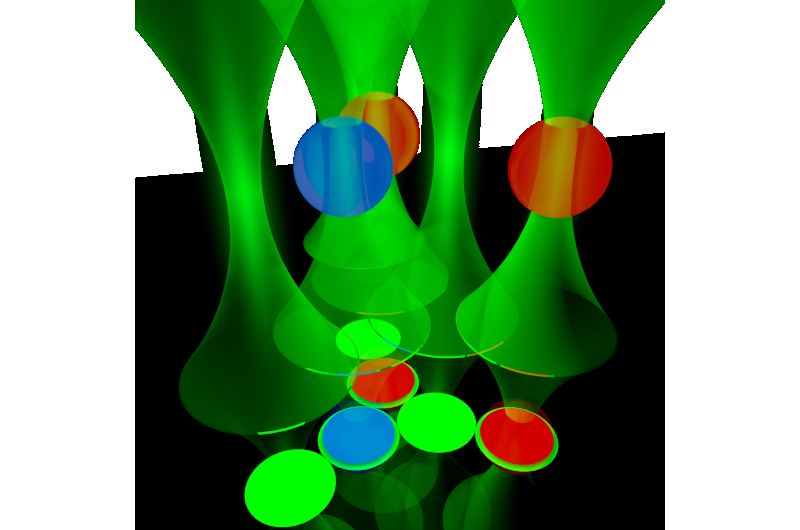2+1 is not always 3: In the microworld unity is not always strength

In the microscopic world, as long as there are only two particles, things are relatively simple. When other particles are introduced, however, the situation soon becomes more complicated. Imagine there are two people pushing a broken-down car: The total force is the sum of their forces. Similarly, if there are three people, the total force would be the sum of the force of these three people, and so on. Now imagine a colloid, a solid particle of a few thousandths of a millimeter, immersed in fluid. Imagine also that just ahead, there is a similar particle. If there are "critical" thermal fluctuations in the fluid that separates them, the two particles will either repel or attract each other without even touching, a phenomenon caused by the fluctuations alone. In other words, an interaction force called the "critical Casimir" force emerges, as if the particles were connected by an invisible spring. Obtain critical fluctuations requires only one of many transparent liquids composed of a mixture of two fluids that gradually separate like oil and water when their temperature is raised.
But what happens when a third colloid is introduced?
"Something counterintuitive," explains SISSA Professor Andrea Gambassi, one of the authors of the study. "The total force that one of the particles 'perceives' is different from the sum of the interactions with the other two particles when they are present separately." For Gambassi, critical Casimir forces are not new. In 2008, he was one of the authors of a study published in Nature Communications in which these forces, predicted theoretically in 1978, were directly measured for the first time. "In simple words," he continues, "these forces do not add up linearly like forces do in our daily life. Here, we are dealing with what physicists call a many-body effect, which is typical of fluctuation-induced forces."
The new study measured this effect for the first time in a system made up of glass (silica) microspheres immersed in fluid. By measuring critical Casimir forces with only two particles and then with three, the researchers demonstrated the nonadditivity of these forces. "The knowledge of these effects is very important from the point of view of both fundamental and applied research, especially for scientists who design micro-machines to perform a variety of tasks. Each micro-machine is made up of several mechanical components in relative motion. And in order to understand how the different 'gears' interact with each other, the knowledge of many-body interaction is crucial, especially in the presence of fluids," explains Gambassi.
Laser beams, optical tweezers, and critical mixtures
The experiment, conducted by the group led by professor Giovanni Volpe at the University of Bilkent in Turkey, starts with colloids immersed in a mixture of water and lutidine (an oily substance). Below 34° C, this mixture is similar to water, but when the temperature is raised, a transition occurs. First, the fluid becomes opaque due to the effects of critical fluctuations. Then the oil begins to separate, floating on the water. "It is around this phase transition that we observe the many-body effects," explains Volpe.
The colloids immersed in liquid move randomly and diffuse via Brownian motion, theoretically explained by Einstein. In order to "confine" them, thin laser beams were focused on one point inside the liquid—when the particles entered the beam, they tended to stay where the light was most intense. In this way, the focused laser acted as optical tweezers. By keeping two colloids close together using two laser beams, it was possible to accurately measure their random motions with a video taken from the microscope. Then, using statistical methods, the forces at play were reconstructed. With the help of a third laser, the researchers added a third particle.
"On approaching the phase transition, when comparing the experiment with two and three colloids, we observed that there was no linear addition of the forces and that many-body effects were present," explains Professor Siegfried Dietrich, director at the Max-Planck Institute for Intelligent Systems in Stuttgart, Germany, and co-author of the study. "Of course, if we added more colloids, the situation would become more complicated and interesting." And Volpe concludes: "In this way, we demonstrated that the many-body effect is real and we succeeded in measuring it with unexpected accuracy, especially when we consider we are dealing with forces of one-thousandth of a millionth of a gram. Now we would like to use them to design and develop new micro-machines."
More information: DOI: 10.1038/NCOMMS11403
Journal information: Nature Communications
Provided by International School of Advanced Studies (SISSA)





















